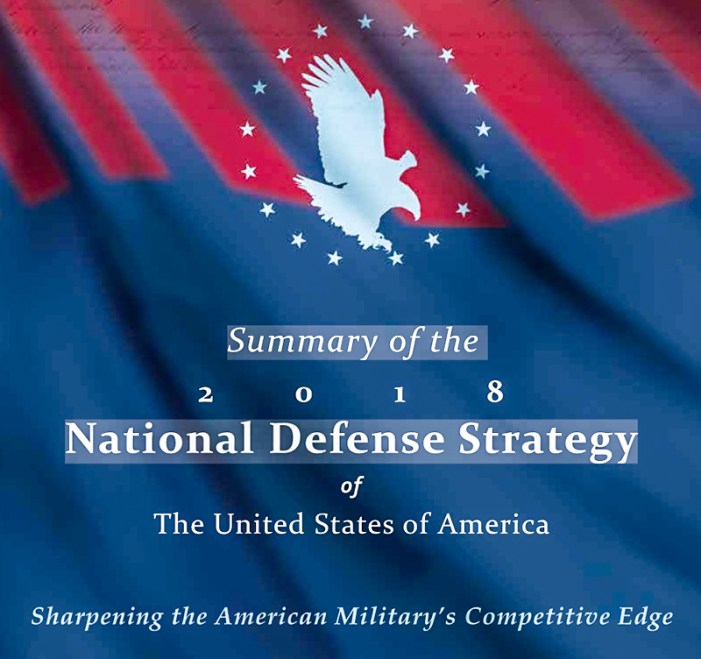How to Read the 2018 U.S. National Defense Strategy
MILITARISM, 29 Jan 2018
Mara Karlin | The Brookings Institution – TRANSCEND Media Service
21 Jan 2018 – Last week, Secretary of Defense Jim Mattis released the 2018-USA National-Defense-Strategy-Summary. Mandated by Congress, the NDS replaces the erstwhile Quadrennial Defense Review. However, it differs in one crucial way: The NDS is classified; therefore, the document Mattis released is an unclassified summary of what is likely a more detailed and far-reaching strategic guidance document for the U.S. Defense Department.
By rolling out the NDS himself, Secretary Mattis succeeded in conveying that this is his strategy, not simply the work of hundreds of diligent Pentagon staffers. That ownership sends a crucial signal to senior defense officials and to members of Congress about his support for and willingness to facilitate its implementation—which will be challenging, to be sure.
At first glance, what is most notable about the NDS is its length and its tenor. At 11 pages, the NDS is approximately 80 percent shorter than its most recent predecessor, the 2014 Quadrennial Defense Review. To their credit, Secretary Mattis and his team largely avoided the “Christmas tree phenomenon” that plagues so many strategies, wherein every participant puts his or her own ornament—or pet issue—in the document. Remarkably, the NDS manages to be both pithy and blunt. As Secretary of Defense Mattis unveiled it last week at the Johns Hopkins University-School of Advanced International Studies, his language was as candid as the NDS itself and should inspire real fear among anyone concerned about U.S. national security: “Our competitive advantage has eroded in every domain of warfare.”
Key Issues for Consideration
In wrestling with a number of defense dilemmas, the NDS enshrines key choices that are largely in line with the defense department’s (somewhat lumbering) trajectory in recent years. According to the strategy, the U.S. military will be able to credibly confront challengers across the spectrum of conflict; it will focus on Asia-Pacific and Europe as the priority theaters while containing chaos in the Middle East; it will take risk in the near-term to build readiness and modernize for future conflicts; and, it will work closely with allies and partners around the world.
Operating in the Future Security Environment:
The NDS’s diagnosis of the future security environment is consonant with today’s commonly accepted analysis across the defense community, as is its prescription for operating in it effectively. While the U.S. military faces five major challenges in line with American national security interests—China, Russia, North Korea, Iran, and terrorists—countering the first two across the spectrum of conflict, including at the high-end and in the gray zone, are prioritized in this strategy. Specifically, this means the U.S. military will bias toward competing with China and Russia, most likely in the South China Sea, and the East China Sea, and Europe, respectively. While competition in the form of countering China and Russia is the preeminent theme of the NDS, the strategy subtly conveys that these two challengers are different, with China appearing to be the first among equals.
The Asia-Pacific and Europe are clearly the major theaters for the U.S. military in NDS implementation; however, the contours of that prioritization—specifically adjustments to posture and investments—are vague in the unclassified strategy. The U.S. military, according to the NDS, will sustain its presence in the Middle East, but will aim to focus on Asia and Europe despite it. This tension plagued the previous administration and will surely be difficult to implement short of Secretary Mattis’s personal and deft hand.
The NDS’s bumper sticker, “Compete, Deter, and Win,” should be viewed through the lens of major competitors, and the emphasis on lethality/modernization and readiness should be understood as helping the U.S. military regain its advantage over China and Russia. According to this strategy, prioritizing preparation for tomorrow and next week’s conflicts will come at the expense of fighting today’s wars against violent non-state actors.
Successfully operating in this future security environment is heavily influenced by U.S. allies and partners, whose role is a key element of the NDS. In unveiling the document, Secretary Mattis reflected that he has always gone to war with other countries’ militaries at his side. Continuing to deepen strategic planning and interoperability with allies and partners is a hallmark of the NDS; however, the Trump administration’s alienation of various U.S. allies and partners over the last year will only make doing so harder.
The Really Wonky Parts:
In reading the NDS, defense strategists will focus on a few wonky parts, namely the force planning construct, force posture and employment, and a few often-orphaned issues that are addressed.
The force planning construct outlines how the U.S. military will be sized and shaped based on the president’s expectations of its abilities. While unclassified descriptions of it are rarely satisfying or clarifying since they do not explain the national security challenges in detail, changes to the unclassified force planning construct belie substantial adjustments to the construction of the future force. The 2018 NDS shifts the force planning construct from its last public, unclassified version which emphasized the military would be able to defeat and deny two aggressors. The new construct hones in on defeating a single major power in addition to a number of different efforts in other regions (including the U.S. homeland). Such adjustments are both smart and in line with the strategy’s emphasis on strategic competition.
The U.S. military is postured and employed around the world; yet its size, shape, and priorities invariably means that the appropriate forces are not always in the right place at the right time. The NDS unveiled a global operating model to help centrally manage posture and make it more “lethal, agile, and resilient,” all in line with facilitating the emphasis on fighting and winning conflicts with China or Russia. Other aspects of this model also make sense, particularly layering forces based on their areas of focus, to include protecting the homeland, competing in gray zone conflict, blunting aggression, and surging in a hot war. How this effort will be implemented and accomplished will be worth watching, not least since previous secretaries of defense have similarly sought to do so. And, efforts to align force management and planning—if successful—can better link how the department manages today’s force consonant with how it develops tomorrow’s force. Nevertheless, doing so will be similarly difficult.
In the often-orphaned issues category, the NDS tackles two topics worth highlighting: operational concepts and professional military education. The inclusion of both issues underscores that fighting and winning in the future must not simply be about the right materiel solution, but also about how the U.S. military employs what it already has—above all, its people. Secretary Mattis’s language on professional military education is among the NDS’s starkest, asserting it has “stagnated, focused more on the accomplishment of mandatory credit at the expense of lethality and ingenuity.” After 15+ years where education was often a breather from the fights in Iraq and Afghanistan, the NDS directly ties time spent in the classroom to success in the war fight.
Paying for it all:
While the NDS says many of the right things, a real reckoning of it is impossible without comparing it to the budget request, which should come out in the next few weeks. A strategy that emphasizes competing with China and Russia, modernizing the future force, and regaining readiness should be reflected in the department’s investments. Simply put, winners and losers should be clear in perusing the defense department’s plans for how it will spend $600+ billion. While the NDS outlines a number of investment areas, including nuclear, space, cyber, and missile defense, it says little about where the department will no longer direct resources. The expected release of the Nuclear Posture Review and the Ballistic Missile Defense Review in the coming weeks will almost surely include eye-popping dollar signs.
The bias toward capability should betray a willingness to cut capacity, which could be manifested in ground force end-strength or in ship numbers, to take two examples. Similarly, the emphasis on buttressing posture in Asia and Europe should have an attendant downward impact on the U.S. military’s activities in the Middle East, Africa, and the Western Hemisphere. If, however, the budget and day-to-day operations of the department do not meaningfully shift, the NDS will be unexecutable.
The NDS’s brief risk section sends a stark message to Congress on funding. “Without sustained and predictable investment to restore readiness and modernize our military to make it fit for our time, we will rapidly lose our military advantage, resulting in a Joint Force that has legacy systems irrelevant to the defense of our people.” To date, Congress has shown an unwillingness to heed similar concerns; one hopes that it will do so this time.
In conclusion, the 2018 National Defense Strategy is a heady attempt to drive the U.S. military faster in the direction it has been heading. China and Russia should read it with a worrying eye (and perhaps a glass of baijiu or vodka).
___________________________________________
 Mara Karlin – Nonresident Senior Fellow, Security and Strategy – Foreign Policy, Center for 21st Century Security and Intelligence
Mara Karlin – Nonresident Senior Fellow, Security and Strategy – Foreign Policy, Center for 21st Century Security and Intelligence
Go to Original – brookings.edu
DISCLAIMER: The statements, views and opinions expressed in pieces republished here are solely those of the authors and do not necessarily represent those of TMS. In accordance with title 17 U.S.C. section 107, this material is distributed without profit to those who have expressed a prior interest in receiving the included information for research and educational purposes. TMS has no affiliation whatsoever with the originator of this article nor is TMS endorsed or sponsored by the originator. “GO TO ORIGINAL” links are provided as a convenience to our readers and allow for verification of authenticity. However, as originating pages are often updated by their originating host sites, the versions posted may not match the versions our readers view when clicking the “GO TO ORIGINAL” links. This site contains copyrighted material the use of which has not always been specifically authorized by the copyright owner. We are making such material available in our efforts to advance understanding of environmental, political, human rights, economic, democracy, scientific, and social justice issues, etc. We believe this constitutes a ‘fair use’ of any such copyrighted material as provided for in section 107 of the US Copyright Law. In accordance with Title 17 U.S.C. Section 107, the material on this site is distributed without profit to those who have expressed a prior interest in receiving the included information for research and educational purposes. For more information go to: http://www.law.cornell.edu/uscode/17/107.shtml. If you wish to use copyrighted material from this site for purposes of your own that go beyond ‘fair use’, you must obtain permission from the copyright owner.
